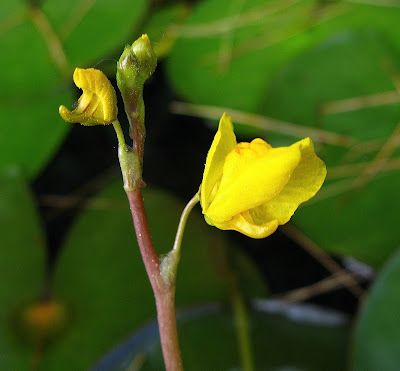 It was a paddler's Paradise: this well-hidden pond (I'm not telling where), surrounded by forest and high craggy cliffs, dotted with floating sphagnum islands where all kinds of marvelous bog plants thrive -- including the beautiful Dragon's Mouth orchid (Arethusa bulbosa), which grows here in such abundance it almost makes it hard to believe this plant is so rare and endangered. Our guide and secret habitat revealer, Evelyn Greene, has counted over 130 individual plants in this pond, a figure I could certainly believe, since we saw many dozens today, and they're almost past their blooming.
It was a paddler's Paradise: this well-hidden pond (I'm not telling where), surrounded by forest and high craggy cliffs, dotted with floating sphagnum islands where all kinds of marvelous bog plants thrive -- including the beautiful Dragon's Mouth orchid (Arethusa bulbosa), which grows here in such abundance it almost makes it hard to believe this plant is so rare and endangered. Our guide and secret habitat revealer, Evelyn Greene, has counted over 130 individual plants in this pond, a figure I could certainly believe, since we saw many dozens today, and they're almost past their blooming.Evelyn introduced me to a new flower-loving friend, Emily DeBolt, and the three of us were joined by another paddler named Sue on a several-hour trip threading our canoes through the bog mats around the pond. Here's a photo of Emily taking pictures of Arethusa. You can see the spots of bright magenta blooms hiding among the grasses.
And here are three of the photos I took of this truly exquisite flower. First, a head-on shot, showing its purple-spotted and yellow-crested tongue.
Second, a three-quarter view.
Third, the flower in profile. (The plant's grass-like leaves won't develop until after the flowers have faded.)
There were many other interesting plants growing among the sedges and moss, including the deep-red Marsh Cinquefoil. (Be sure to click on this photo to better see the shiny spoon-shaped anthers rimmed with golden pollen.)
Tall and stately Blue Flags raised their striking blooms above the grasses.
Tiny Spatulate-leaved Sundew grew abundantly on muddy flats and rotting logs.
Sheep Laurel's deep-pink blossom clusters are topped by a terminal tassel of leaves, one of the ways to distinguish this laurel from the earlier blooming, now faded, Bog Laurel.
We found several species of bladderworts, including the Flat-leaved and the Common. My photo of the Flat-leaved came out all blurry, but the Common Bladderwort's photo came out fine. Both of these unrooted, floating plants obtain their nutrients by capturing tiny organisms in minute inflatable sacs that cluster along their underwater leaves.
At one point, Emily and I pushed our boats up onto the sphagnum mat and climbed out to investigate what bog plants were growing there. I had never before seen so many Pitcher Plants in one place.
Small Cranberry (small pale-pink flowers and tiny leaves) and Bog Buckbean (three-lobed green leaves) join the Pitcher Plant pitchers on this soggy patch of sphagnum.
Not all of our discoveries were floral. Numerous species of dragonflies darted about the bog, and a family of Canada Geese cruised by on several occasions, fluffy goslings paddling close between goose and gander. I don't know what happened to Mother Duck that she left her nest filled with these eggs. Perhaps our approach frightened her off. I hope the hot sun kept them warm.
On our way home, I spotted this beautiful bird in a marsh by the side of the highway and, risking accident, promptly performed a U-turn to obtain a better view. It's not every day we see a White Egret in the Adirondacks.













5 comments:
Ooo - nice arethusas! Evelyn and I visited a pond a couple years ago that yielded close to 130 of them...I'm wondering if this is where you were! Looks like you had a perfect day for this boater's botanizing bonanza!
Hi Jackie,
I left a longer message on your May 26 post (along with my blog address) because I just loved the tree photos. But this today with the orchids and other beautiful flowers is exquisite. No wonder you always want your camera with you, even on the water!
--Virginia
Thanks for sharing these wonderful images, Jackie! I love paddling among the life in bogs and fens, too, but have not seen Arethusa before, although I encounter lots of Rose Pogonia in July. Your info makes me wonder if perhaps I merely got into the bogs too late in the year. Does Arethusa bloom weeks before Pogonia ophioglossoides?
Hi Ellen. Yup, I'll be it's the same pond. Evelyn remarked that she had brought you there.
Hi Virginia, so good to see you at your Mom's show and to visit with you again via our blogs. I'm glad to have access now to yours.
Hi Wayne, thanks for your kind comment. Yes, Arethusa blooms weeks earlier than Rose Pogonia. Usually. I was out on the River near Warrensburg today and found Rose Pogonia just starting to bloom. The Arethusa is near the end of its blooming time. It's also a much rarer plant, classified as endangered in NY state. So we were very lucky to find them. Or should I say, lucky to have Evelyn to show us where they grow? That woman knows where EVERYTHING grows!
Sounds awesome!!
Post a Comment